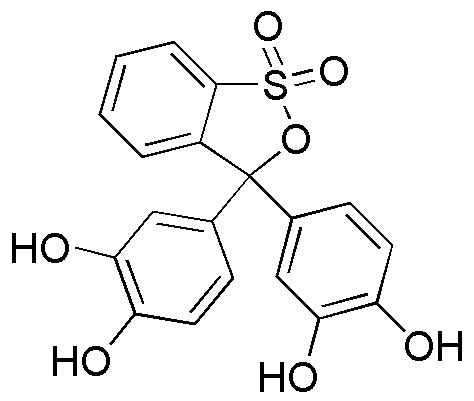Pyrocatechol Violet is widely utilized in research focused on:
- Histology and Pathology: This compound is commonly used as a staining agent in tissue samples, allowing researchers to visualize cellular structures under a microscope, which is crucial for diagnosing diseases.
- Analytical Chemistry: It serves as a reagent in various analytical methods, helping to identify and quantify phenolic compounds in environmental samples, thus aiding in pollution monitoring.
- Biotechnology: In the development of biosensors, Pyrocatechol Violet is employed for detecting specific biomolecules, enhancing the sensitivity and accuracy of diagnostic tests.
- Pharmaceutical Research: The compound is used in drug formulation studies, particularly in assessing the stability and efficacy of pharmaceutical products, ensuring they meet safety standards.
- Textile Industry: It acts as a dye for fabrics, providing vibrant colors while being less toxic compared to some traditional dyes, making it a safer choice for manufacturers and consumers.
General Information
Properties
Safety and Regulations
Applications
Pyrocatechol Violet is widely utilized in research focused on:
- Histology and Pathology: This compound is commonly used as a staining agent in tissue samples, allowing researchers to visualize cellular structures under a microscope, which is crucial for diagnosing diseases.
- Analytical Chemistry: It serves as a reagent in various analytical methods, helping to identify and quantify phenolic compounds in environmental samples, thus aiding in pollution monitoring.
- Biotechnology: In the development of biosensors, Pyrocatechol Violet is employed for detecting specific biomolecules, enhancing the sensitivity and accuracy of diagnostic tests.
- Pharmaceutical Research: The compound is used in drug formulation studies, particularly in assessing the stability and efficacy of pharmaceutical products, ensuring they meet safety standards.
- Textile Industry: It acts as a dye for fabrics, providing vibrant colors while being less toxic compared to some traditional dyes, making it a safer choice for manufacturers and consumers.
Documents
Safety Data Sheets (SDS)
The SDS provides comprehensive safety information on handling, storage, and disposal of the product.
Product Specification (PS)
The PS provides a comprehensive breakdown of the product’s properties, including chemical composition, physical state, purity, and storage requirements. It also details acceptable quality ranges and the product's intended applications.
Certificates of Analysis (COA)
Search for Certificates of Analysis (COA) by entering the products Lot Number. Lot and Batch Numbers can be found on a product’s label following the words ‘Lot’ or ‘Batch’.
*Catalog Number
*Lot Number
Certificates Of Origin (COO)
This COO confirms the country where the product was manufactured, and also details the materials and components used in it and whether it is derived from natural, synthetic, or other specific sources. This certificate may be required for customs, trade, and regulatory compliance.
*Catalog Number
*Lot Number
Safety Data Sheets (SDS)
The SDS provides comprehensive safety information on handling, storage, and disposal of the product.
DownloadProduct Specification (PS)
The PS provides a comprehensive breakdown of the product’s properties, including chemical composition, physical state, purity, and storage requirements. It also details acceptable quality ranges and the product's intended applications.
DownloadCertificates of Analysis (COA)
Search for Certificates of Analysis (COA) by entering the products Lot Number. Lot and Batch Numbers can be found on a product’s label following the words ‘Lot’ or ‘Batch’.
*Catalog Number
*Lot Number
Certificates Of Origin (COO)
This COO confirms the country where the product was manufactured, and also details the materials and components used in it and whether it is derived from natural, synthetic, or other specific sources. This certificate may be required for customs, trade, and regulatory compliance.


